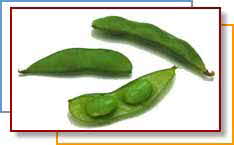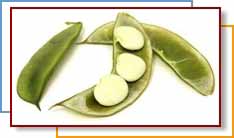Home | FOOD ARTICLES | Food Trivia | Today_in_Food_History | Food_History_Timeline | Recipes | Cooking_Tips | Food_Videos | Food_Quotes | Who’s_Who | Culinary_Schools_&_Tours | Food_Trivia_Quizzes | Food_Poems | Free_Magazines | Food_Festivals_and_Events
Food Articles, News & Features Section
FREE Magazines
and other Publications
Free Professional and Technical Research, White Papers, Case Studies, Magazines, and eBooks
See also: Beans HIstory & Nutrition; Dried Beans
Also look under name of specific beans.
FRESH BEANS
Fresh beans are classified into two basic categories: edible pod beans and shell beans. Green beans, otherwise known as snap or string beans, are the most popular edible pod bean in the United States. The lima bean is the most common shell bean sold in the United States.
Edamame, a shell bean, is also called an immature green soybean. The popularity of this bean has grown in the past decade and is now easily found frozen in most major supermarkets.
VARIETIES Edamame
Edamame
Edamame is of Chinese origin and was developed in Japan especially for eating out of the pod. Edamame is a variation on the same yellow and black field soybean that is transformed into many popular soy products such as tofu, miso, and soymilk. However, because of its recent introduction into the U.S. market, only a small percentage of U.S. soybean fields are devoted to growing edamame.
Some call edamame the super or wonder vegetable because it is the only vegetable that contains all nine essential amino acids. This makes edamame a complete protein source, similar to meat or eggs. Edamame also contains isoflavonoids. They are found in all soy products and are being studied for their health benefits.
Availability: Edamame is rarely sold fresh, but is available frozen all year.
Preparation: To eat beans right out of the shell, boil them until they are al dente (still slightly firm). Rinse to cool slightly, and season as desired. You can easily suck the al dente beans out of the shell. Beans may also be shelled and added to other dishes, such as salads. Beans are easy to shell after they are boiled briefly.
 Green Beans
Green Beans
These beans are often called string beans because years ago a fibrous string ran along the seam of the bean. The string was noticeable when you snapped off the ends. The snapping noise is the reason for its other nickname.
Availability: Fresh green beans are available all year, with a peak season of May to October. Green beans are also available canned and frozen.
Selection: It is best to handpick green beans from a market that sells them loose. To ensure uniform cooking time, select beans of similar size and shape. Choose slender beans (no thicker than a pencil) that are crisp and free of blemishes. The beans should be a bright green color. Do not purchase beans that are stiff or have the seeds visible through the pod because those beans will be tough.
Storage: Keep green beans dry in a perforated plastic bag in the refrigerator. They should stay fresh for 4 to 5 days.
Preparation: Wash beans thoroughly in clear, cool water. Beans can be cooked whole, cut crosswise or diagonally, or French-cut (i.e., cut along the length of the bean). If you want sweet tasting, crisp fresh beans, cut them as little as possible. Cut older, more mature beans in the French style (i.e., lengthwise).
Stir-frying is one of the easiest ways to prepare green beans. This method maintains more nutrients than other cooking methods. Whatever cooking method you choose, remember to cook beans as little as possible, using the least amount of water possible.
Boiling, steaming, and microwaving are other common methods for preparing green beans. When boiling, beans may release some nutrients into the water, so try to re-use the bean water to regain some of the nutrients lost. For example, you can use the water to boil rice.
TIP: Green beans continue to cook after you take them out of the boiling water. Either take them out just before they are cooked the way you like, or plunge them into ice water immediately to stop them cooking further. TIP: The fewer beans in the pan, the quicker they cook and the better they taste. If cooking more than one pound at a time, use separate pans.
Lima Beans
Lima beans originated in Peru and have been grown there since 6000 B.C. The name lima bean comes from the capital city of Peru, Lima. Lima beans are often nicknamed chad beans or butter beans. In the southern part of the United States, lima beans are almost always called butter beans, even in markets and restaurants.
Varieties: Lima beans come in three main varieties: large, small, and dwarf.
Large lima beans are green or speckled. The speckled kind have a creamy texture and a strong earthy flavor, unlike the pale green ones.
Small lima beans are also called sieva beans and have several other nicknames, such as Carolina bean, civet, seewee, and sivvy. Most small limas are pale green. Small limas are less starchy than the larger varieties.
Dwarf beans, also known as butter peas, are white and speckled and the least starchy of the limas.
Availability: Fresh lima beans are difficult to find in the United States, but can occasionally be found at farmers markets. It is easier to find lima beans in the southern United States than anywhere else in the country. Most lima beans are dried, canned, or frozen.
Preparation: Fresh lima beans need to be shelled before they are eaten. Shelling can be a little tricky, especially with larger beans. Beans are easier to handle if they are tender and have full pods. One method used for larger beans is to simply cut open the pod with scissors and remove the beans by hand. To remove the beans from smaller limas, pull off the string along the seam, and press the two sides open to pop the beans out. Rinse canned limas before using them to reduce their gas-promoting properties.
Lima beans should never be eaten raw (see warning below). The most common methods of preparation are boiling and microwaving. Only a small amount of water needs to be used for either method.
WARNING: Do not eat raw lima beans. They contain linamarin (also called cyanogen), which releases a cyanide compound when the seed coat is opened. Don’t worry; cooking deactivates this compound. The United States sets regulations to restrict commercially grown lima beans to those varieties with very low levels of this linamarin, but lima beans grown elsewhere, may have 20 to 30 times the concentration allowed in the United States.
- Eat edamame beans as a snack right out of the pod.
- Add color, texture, vitamins, minerals, and fiber to your diet by adding fresh beans to your favorite vegetable soup.
- Steamed green beans are a healthy and crunchy addition to any green or pasta salad.
- Sprinkle lemon juice and dill over steamed green beans for a tangy side dish.
- Make succotash with lima beans and corn as a substitute for rice or potatoes.
RELATED ARTICLES
Please feel free to link to any pages of FoodReference.com from your website.
For permission to use any of this content please E-mail: james@foodreference.com
All contents are copyright © 1990 - 2026 James T. Ehler and www.FoodReference.com unless otherwise noted. All rights reserved.
You may copy and use portions of this website for non-commercial, personal use only.
Any other use of these materials without prior written authorization is not very nice and violates the copyright.
Please take the time to request permission.


